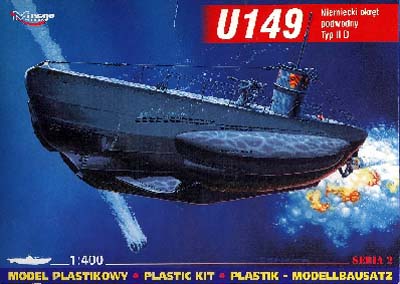
Mirage 1/400 U149 Type IID
U-Boat Kit
Review by Javier Hueso
Despite the efforts of Admiral Dönitz to expand
the U-boat fleet, the Type II was the mainstay of the Ubootwaffe at the
outbreak of World War II. These boats were small, with a maximum displacement
of 460 tonnes, an overall length of 43.97 meters (144.25 feet) and a maximum
breadth of 4.92 meters (16.14 feet). Because of the small size, they had
only three torpedo tubes and capacity for only five "eels". Yet they were
pressed into war service because the scarcity of ships and only the D variant
had legs long enough to reach the western coast of the United Kingdom.
This due to the use of saddle tanks, like those found on the Type VII,
which increased the bunkerage and Kort nozzles (which were a sort of shroud
around the propellers) which attempted to improve propulsive efficiency.
Descendants of the UF Type of World War I, the Type II were regarded as
training boats, and as such employed when better submarines became available
in numbers, but they saw operational employment in the Black Sea up to
1944.
The Mirage model is an interesting little kit, but one
has to wonder why such an enormous box (measuring 25cm x 18cm) was used
to package a model which is barely 11 centimetres overall. The kit is moulded
in a somewhat thick, but soft, creased, grey plastic, which results in
some overscale issues with are somewhat offset by a more than adequate
grade of detail for such a little model. Parts are provided to give the
modeller the option of building the boat as either pre- or post-1942 (addition
of snorkel and suppression of net cutter).
There are 28 pieces, among them 2 for the hull,
one for the deck and two for the conning tower. They are trouble free,
except for an ejection pin in the inside of the bridge parts and in the
stand, and a sinkhole in part D 7, which appears to be the snorkel. There
is a discrepancy in stage III of the instruction sheet, which mislabels
part 10 as part 15. Also, piece 6 is not used. As noted, some parts are
overscale, such as the 20mm gun and the net cutter (the former is also
a little short-barrelled). The propellers are moulded flat, as is very
difficult to give an adequate pitch in such a small item in this scale
(they measure about 3mm in diameter), but they are nearly hidden by the
nozzles when mounted. The bulged torpedo tube doors are missing and the
limber holes are rounded, not rectangular as in the original. The prominent
rails around the bridge are not provided. Examples of the detail include
the life preserver and navigation lights that are moulded integrally into
the tower. While the limber holes are the wrong shape, the kit has a neat
depiction of their complex layout as well as an adequate representation
of the deck planking and fittings. The model scales to the right overall
length but it is about 80 scale centimetres narrower than the maximum breadth.
Decals for U137 and U 149 are provided, which are
very tiny but neat, and includes boat's crest; however the flag's swastika
is substituted for a cross and a series of points. The instruction sheet
is provided only in Polish, but it is easily followed and includes a brief
historical background. A colour chart is provided for Humbrol, AGAMA and
RAL ranges.
Regarding assembly, the biggest trouble appears
to be the lacking of alignment tabs between hull halves and deck, and between
tower parts, the addition of tube doors, the smallness of items such the
propellers and the need of thinning others, like the propeller's nozzles.
It is a nice and easy kit of a "minor" but important
weapon of the German Submarine Force, which could be built into a beautiful
model with a little effort (but maybe with the help of a magnifier!).
Click on thumbnail for a full-size picture
|